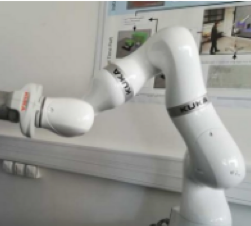Human-centered production system is one of the pillars of Industry of Future (IoF). Regarding robotics, in most cases, the context consists in making the robots collaborating with human to perform together tasks such as machining, assembly, or manipulation. While the human operators are not controllable – are umpredictible and have limitation in some performances measures (repeatability, precision, vibrations), the robots on the other hand are controllable – predictible and can bring these performances to the collaboration. Beyond the performances, safety and ergonomy for the human should also be ensured in order to prevent from accidents and musculoskeletal disorders risks [bi21,xi22]. It is obvious that the more information we have during the collaboration, higher is the chance to accomplish the specified performances – safety and ergonomy.
SPHAND project consists in developing a smart and mechatronic device embedded onto a robotic hand and that will be used to provide more information and actuation when the latter manipulates an object or co-manipulates it with a human. This increase in information collection and actuation will allow an entire robotic platform encompassing the robotic hand to increase in interaction capability. To attain the proposed smart and mechatronic device, we propose to explore piezoelectric self-sensing (PSS). It consists of a delicate combination of both the converse piezoelectric (for actuation) and the direct piezoelectric effects (for sensing). PSS features: better integration (actuation and sensing from the same elements), lower cost than distinct actuation and sensing combined, more functionality than actuation only and than sensing only.
Since its invention [do92], PSS is widely used for vibrations control due to its high frequency efficacity [ru16]. Precision was not considered, instead only bandwidth and Q-factor qualities. In [ra09], we proposed suitable electronic circuitry and observer for PSS to allow it measure precisely constant and low frequency displacement signals. Further we extended it to simultaneously measure force, displacement, velocity and acceleration signals of a piezoelectric layout at constant, low and high frequency conditions [ra13].
To fit with the targeted application, the PSS to be developed in SPHAND is a distributed piezoelectric self-sensing which itself is scientifically novel against the literature. A device that consists of distributed piezoelectric elements able to actuate and to sense will therefore be studied, fabricated and tested. Specific care will be taken on the materials choice to maximize eco-friendliness of the device. Beyond robotic manipulation, such piezoelectric self-sensing device can also be adapted for other applications like diagnosis and wearable devices in medical domain and tactile boards or surfaces in automotive/aerospace domain.
Human-centered production system is one of the pillars of Industry of Future (IoF). Regarding robotics, in most cases, the context consists in making the robots collaborating with human to perform together tasks such as machining, assembly, or manipulation. While the human operators are not controllable – are umpredictible and have limitation in some performances measures (repeatability, precision, vibrations), the robots on the other hand are controllable – predictible and can bring these performances to the collaboration. Beyond the performances, safety and ergonomy for the human should also be ensured in order to prevent from accidents and musculoskeletal disorders risks [bi21,xi22]. It is obvious that the more information we have during the collaboration, higher is the chance to accomplish the specified performances – safety and ergonomy.
SPHAND project consists in developing a smart and mechatronic device embedded onto a robotic hand and that will be used to provide more information and actuation when the latter manipulates an object or co-manipulates it with a human. This increase in information collection and actuation will allow an entire robotic platform encompassing the robotic hand to increase in interaction capability. To attain the proposed smart and mechatronic device, we propose to explore piezoelectric self-sensing (PSS). It consists of a delicate combination of both the converse piezoelectric (for actuation) and the direct piezoelectric effects (for sensing). PSS features: better integration (actuation and sensing from the same elements), lower cost than distinct actuation and sensing combined, more functionality than actuation only and than sensing only.
Since its invention [do92], PSS is widely used for vibrations control due to its high frequency efficacity [ru16]. Precision was not considered, instead only bandwidth and Q-factor qualities. In [ra09], we proposed suitable electronic circuitry and observer for PSS to allow it measure precisely constant and low frequency displacement signals. Further we extended it to simultaneously measure force, displacement, velocity and acceleration signals of a piezoelectric layout at constant, low and high frequency conditions [ra13].
To fit with the targeted application, the PSS to be developed in SPHAND is a distributed piezoelectric self-sensing which itself is scientifically novel against the literature. A device that consists of distributed piezoelectric elements able to actuate and to sense will therefore be studied, fabricated and tested. Specific care will be taken on the materials choice to maximize eco-friendliness of the device. Beyond robotic manipulation, such piezoelectric self-sensing device can also be adapted for other applications like diagnosis and wearable devices in medical domain and tactile boards or surfaces in automotive/aerospace domain.



